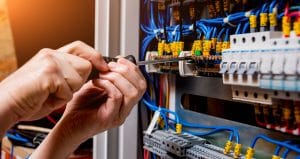 Technology has always been a part of modern industry in some form or another, and these days, it’s a dominant factor in any company’s operations. That includes those in industries that traditionally work in conditions that require additional safety and precautionary measures. Electrical enclosures, control panels, and more that are exposed to higher-than-usual risks of contamination or overheating must often adhere strictly the standards set forth by the National Electrical Manufacturers Association (NEMA). These standards help ensure the safety of employees and the environment in which certain forms of technology operate. They can also make implementing an effective thermal management solution more challenging, which is one reason why heat exchangers are often recommended for them.
Technology has always been a part of modern industry in some form or another, and these days, it’s a dominant factor in any company’s operations. That includes those in industries that traditionally work in conditions that require additional safety and precautionary measures. Electrical enclosures, control panels, and more that are exposed to higher-than-usual risks of contamination or overheating must often adhere strictly the standards set forth by the National Electrical Manufacturers Association (NEMA). These standards help ensure the safety of employees and the environment in which certain forms of technology operate. They can also make implementing an effective thermal management solution more challenging, which is one reason why heat exchangers are often recommended for them.
What are NEMA standards?
NEMA’s various standards are a set of regulations designed to ensure that electrical enclosures in high-risk areas are properly controlled and protected. The standards range from mild to severe risks, with levels of protective measures appropriate to each grade, and every aspect of the equipment used must meet those standards. That includes cooling solutions, which used to be mainly comprised of air conditioning or air compression units. Heat exchangers are a popular option for electrical enclosures because of their highly efficient and eco-friendly heat transfer capabilities. However, they’re also often ideal for specific NEMA-grade applications because of their high-performance design and neoprene seals, which offer consistent protection for electrical enclosures without any loss in thermal management capabilities.
How heat exchangers cool enclosures
A heat exchanger works by using an environmentally safe cooling fluid, such as water, to absorb the electrical waste heat generated within an electrical enclosure. The fluid absorbs the heat and transfers it to a cooler area that’s well-removed from any sensitive components. Then, it can release or dissipate the heat before cycling back toward the heat source to absorb more. This occurs in a continuous cycle within the heat exchanger, allowing it to continuously transfer waste heat and prevent it from accumulating into heat pockets in the enclosure.
What that means for modern companies
The fact that more companies are implementing NEMA-standard enclosures is a testament to their commitment to safety. With the help of advanced, often custom-designed heat exchangers, companies can also provide optimal thermal management for those enclosures at minimal costs and without having to invest in more energy. In fact, heat exchangers typically require less energy and less maintenance throughout their lifespan compared to more traditional solutions, so companies save on costs as well as boost their productivity, safety, and eco-friendliness.
For more information about how heat exchangers efficiently cool NEMA-class enclosures, call Noren Thermal Solutions in Taylor, TX, at 866-936-6736.







